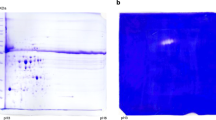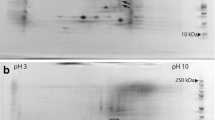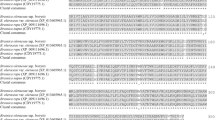Abstract
An abundant 39 kDa protein was detected in the apoplast of leaves 12 days after infection of Brassica napus L. (canola) by the blackleg fungus, Leptosphaeria maculans (Desm.) Ces. & de Not. This protein was also present 24 h after leaves were sprayed with 5 mM cupric chloride, indicating that it is produced by B. napus in response to stress. Tryptic peptides cleaved from this protein had almost identical amino acid sequence to part of a 1,3-β-glucanase from B. rapa.
Similar content being viewed by others
References
Chen C-Y, Howlett BJ (1996) Rapid necrosis of guard cells is associated with the arrest of fungal growth in leaves of Indian mustard (Brassica juncea) inoculated with avirulent isolates of Leptosphaeria maculans. Physiological and Molecular Plant Pathology 48, 73–81.
De Wit PJGM, Spikman G (1982) Evidence for the occurrence of race and cultivar-specific elicitors of necrosis in intercellular fluids of compatible interactions of Cladosporium fulvum and tomato. Physiological Plant Pathology 21, 1–11.
Dixelius C (1994) Presence of the pathogenesis-related proteins 2, Q and S in stressed Brassica napus and B. nigra plantlets. Physiological and Molecular Plant Pathology 44, 1–8.
Flannery AV, Beynon RJ, Bond JS (1993) Proteolysis of proteins for sequence analysis and peptide mapping. In ‘Proteolytic enzymes: a practical approach’. (Eds RJ Beynon and JS Bond) pp. 145–161. (IRL Press: Oxford, UK)
Hammond KE, Lewis BG, Musa TM (1985) A systemic pathway in the infection of oilseed rape plants by Leptosphaeria maculans. Plant Pathology 34, 557–565.
Joosten MHAJ, de Wit PJGM (1989) Identification of several pathogenesis-related proteins in tomato leaves inoculated with Cladosporium fulvum as 1,3-β-glucanases and chitinases. Plant Physiology 89, 945–951.
Matsudaira P (1990) Limited N-terminal sequence analysis. Methods in Enzymology 182, 602–613.
Newman MA, Conrads-Strauch J, Scofield G, Daniels MJ, Dow JM (1994) Defense-related gene induction in Brassica campestris in response to defined mutants of Xanthomonas campestris with altered pathogenicity. Molecular Plant-Microbe Interactions 7, 553–563.
Purwantara A, Salisbury PA, Burton WA, Howlett BJ (1998) Reaction of Brassica juncea (Indian mustard) lines to Australian isolates of Leptosphaeria maculans under glasshouse and field conditions. European Journal of Plant Pathology 104, 895–902.
Rouxel T, Sarniguet A, Kollman A, Bousquet J (1989) Accumulation of a phytoalexin in Brassica spp. in relation to a hypersensitive reaction to Leptosphaeria maculans. Physiological and Molecular Plant Pathology 34, 507–517.
Williams RH, Fitt BDL (1999) Differentiating A and B groups of Leptosphaeria maculans, causal agent of stem canker (blackleg) of oilseed rape. Plant Pathology 48, 161–175.
Author information
Authors and Affiliations
Corresponding author
Rights and permissions
About this article
Cite this article
Brownfield, L., Howlett, B.J. An abundant 39 kDa protein from Brassica napus (canola) is present in the apoplast of leaves infected by the blackleg fungus, Leptosphaeria maculans. Australasian Plant Pathology 30, 7–9 (2001). https://doi.org/10.1071/AP00057
Received:
Accepted:
Published:
Issue Date:
DOI: https://doi.org/10.1071/AP00057




